Project Log: Saturday, October 16, 2010
The major demolition was nearly complete, and already I
was starting to look ahead to the grinding, sanding, and
surface prep portions of the project, which would follow
closely on the heels of the completion of unbuilding.
To that end, I spent part of the morning cleaning up and
organizing the shop a bit. Shop bay 2 tends to end
up being a bit of a catch-all for various
equipment--shop-related and otherwise--and general
clutter that accumulates there as part of my effort to
keep the wood shop and shop bay 1 clear of such
detritus. With some messier work on the horizon, I
wanted to keep the area around the boat as free and
clear as I could to reduce cleaning nuisance.
Later, I vacuumed up the dried mud bits inside the boat,
the result of my spreading around the still-wet product
some weeks ago with this intent in mind. Any
further silt and dirty residues inside the boat would be
addressed during the interior sanding, coming up soon.
The decks featured old gray Treadmaster non-skid
appliqué. The Treadmaster was badly worn in
several areas, slightly loose and curling around some of
the edges, and generally in not-so-good condition; plus,
it was ugly as anything, and far too aggressive for my
tastes or needs. While I appreciate the excellent
nonskid qualities of this product, I've never liked it
and didn't want it on the boat. In any event, with
the entire deck to be refinished, the old material had
to go. Though I was well acquainted with
Treadmaster in a theoretical sense, I'd never actually
worked with it, nor had to remove it. |
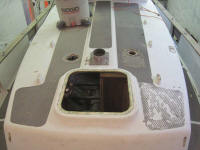
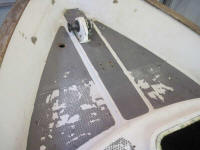
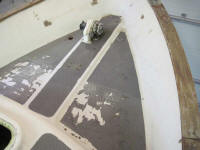

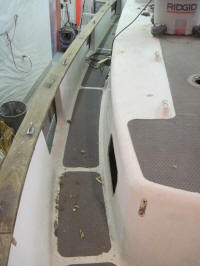 |
This turned out to be an unpleasant chore. I'd not
anticipated it being fun, exactly, but neither did I
expect it to be quite so slow and difficult. I
started on the coachroof, which featured three long
sections of the Treadmaster. With a heat gun, I
warmed the surface, hoping to loosen the adhesive's bond
with the substrate, and used a heavy angled putty knife
to lift and scrape away the cork-based nonskid material. |
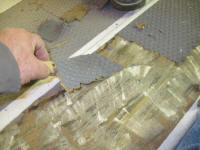 |
I'm not sure what the adhesive was, but it was very
tough: it seemed to be more along the lines of a
semi-flexible polyurethane-type rather than an
epoxy-type. As a result, while heat and scraping
ultimately worked to remove most of the material (but
not the adhesive residue), the process was not only
slow, but far more difficult physically than I'd
expected. The heat served only to make the removal
of the Treadmaster possible, but not easy.
In fact, it required plenty of strength to push the
knife beneath, while holding the heat gun at the same
time to release (in a manner of speaking) the adhesive
ahead of the blade.
During the afternoon work session (3.25 hours), I
managed to remove two of the three sections of
Treadmaster covering the coach roof--not the progress
for which I'd hoped at the beginning. In addition,
there was still plenty of extremely well-adhered
adhesive still on the deck, which I'd remove during
later sanding steps.
As a result, I decided next time to try simply sanding
away the Treadmaster on a test area, since I'd have so
much sanding ahead anyway; frankly, I thought prefer
sanding to the difficult scraping, and perhaps the cork
would sand away easily. In any event, I was less
than enthused with the idea of facing another several
days of the arduous scraping I'd just endured. |

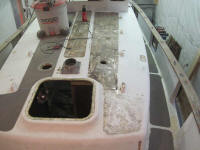
|
Total Time Today: 5.25 hours
|
<
Previous |
Next > |
|
|









